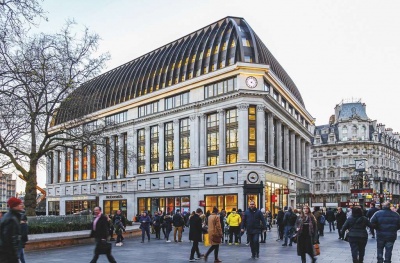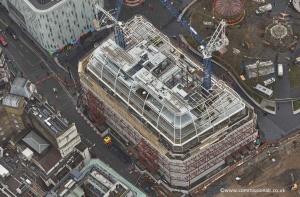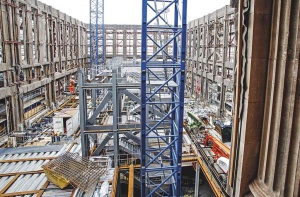LSQ London.
Structural Steel Design Awards 2017 - Award
LSQ London is a Grade II listed building refurbishment, which required over 2,000 tonnes of structural steel and metal decking to be installed within what is thought to be Europe’s largest retained façade. Situated in London’s busiest tourist area, this project required meticulous planning and organisation to ensure the most efficient use of time and craneage without bringing the surrounding streets to a standstill.
The completed building was erected to the required tolerance of 15mm over the full height, making this project challenging for the engineering and delivery teams, but was completed on time, to budget and to the client’s satisfaction.
The existing building envelope is partially retained with new upper storeys of commercial floor space being provided. The design delivers two basements, two floors of retail space and seven floors of high quality office space with a new entrance on Whitcomb Street. Upper floors are enclosed by a new curved mansard roof. On the lower floors, new retail space has created active frontages at street level with new, clearly defined entrances.
The contemporary roof design is supported by a structural steel-framed central core and new perimeter stanchions, with complete column-free office space and spans of up to 12m providing very efficient floor space to appropriate market standards.
A new two-storey basement was created by the installation of a secant piled wall inside the retained façade profile. Shallow floor construction was used for the B1 and ground floor slabs to maximise headroom in below ground spaces, whilst minimising excavation depths.
The project was designed using Revit 3D modelling techniques to capture the integration and interfaces of both architecture and building services. This assisted the design and construction activities, but also provides full integrated models for future use.
The design of the building naturally leant itself to using steel for the primary structural elements. The design of the new steel structure introduced a new central core, and enabled clear, open-plan floorplates, improving the office spaces within the building. One of the key aspects of the façade retention scheme was the alignment of new floors with existing window openings. This was assisted by integrating the suspended services within the structural downstand beam zone, such that the depth of floor zone against the façade was minimised. The use of a steel frame offered the flexibility needed to suit the various interfaces that occur with the existing façade.
The steel-framed façade dates from the 1920s and 1930s, however some areas were added during the 1960s. The steel columns are all encased in Portland stone and consequently in good condition. However, steelwork originating from various decades required extensive laboratory tests to determine its make-up and suitability prior to making the welded connections for 250 new façade retention brackets. This demonstrates the adaptability of steel-framed structures both old and new.
The new fifth floor is clad with Portland stone to integrate with the retained façade below. This floor level’s steelwork is topped with a ring beam that goes around the entire perimeter of the building.
The ring beam is formed from jumbo box sections measuring 650mm × 450mm with a 25mm thickness. The sections were brought to site in 3.5m long sections each weighing three tonnes. The box section ring beam performs two functions, one is to support the columns for the feature roof as these are not aligned with the main columns for the rest of the building, and the second function is for the stone cladding panels for the sixth floor as they are hung from the beam.
The steel feature roof slopes outwards from the two centrally-positioned cores and is formed with a cranked steel frame, which in turn supports a lightweight aluminium frame and glazing. This new and elegant curved mansard roof encloses the building and offers a modern interpretation of the traditional mansard style where arch geometry sits atop a classical base. This respectful, contemporary addition to the building composition reduces the existing top-heavy visual mass of the building and, with the curved design, also seeks to ensure the building blends in seamlessly with the surrounding iconic buildings of Leicester Square.
| Architect | make |
| Structural Engineer | Waterman Structures |
| Steelwork Contractor | Bourne Steel Ltd. |
| Main Contractor | Multiplex Construction Europe Ltd. |
| Client | Linseed Assets Ltd. |
Judges' comment
The use of structural steel for the new internal structure, including cores, enabled new clear-span floorplates to be achieved, whilst respecting the existing listed façade. It minimised disruption during construction in London’s busiest tourist area.
With its graceful three-storey ‘top-knot’, the building has a new lease of life as a striking yet respectful landmark in the West End.
This project showcases the role steelwork can play in the extension and re-purposing of historic buildings.






